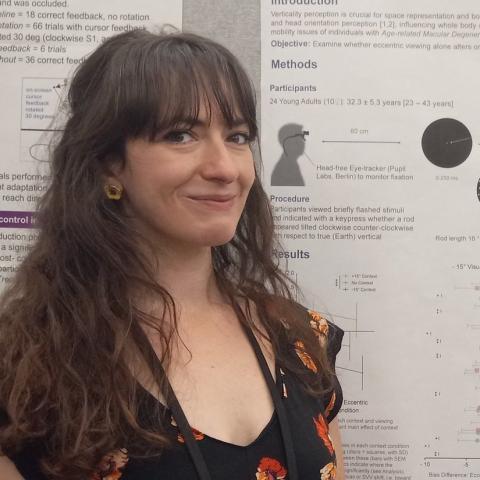Abstract
Multisensory integration is essential for postural control and enabling safe navigation. The vestibular system plays a crucial role in these processes, contributing to functions important for maintaining one’s autonomy, such as balance, oculomotor control and spatial orientation. Healthy aging is accompanied by a decline in many perceptual, cognitive, and motor abilities, however, potentially leading to a loss of autonomy and increased health risks, most notably falls. Age-related macular degeneration (AMD), the leading cause of irreversible visual impairment in older adults in industrialized countries, adds another layer of complexity to these age-related changes.
Binocular AMD results in central visual field loss, forcing individuals to adopt eccentric viewing strategies and develop preferred retinal loci (PRLs) in the peripheral retina. This adaptation calls for significant oculomotor and eye-head coordination changes that would require a recalibration with the vestibular system in particular. The interplay of visual impairment, altered oculomotor function, and age-related sensorimotor deficits likely contributes to the balance and mobility difficulties reported in this population, though the mechanisms are poorly understood. For instance, how does the combined loss of central vision and associated oculomotor changes affect visual sampling during motion, space representation, and the integration of visual and body-based signals necessary for accurate perception and adaptive movements? Little is known about whether and how older individuals with AMD adapt to a peripheral PRL in the context of spatial orientation and postural control.
In this talk, I will present relevant work from the literature and my studies in healthy aging and central field loss. I will then introduce an R01 proposal evolving from this research, which examines the recalibration of different sensorimotor systems to a PRL in individuals with AMD. The proposal focuses on three key areas: 1) head stabilization and the exploitation of residual vision, 2) gaze-direction induced illusions in spatial orientation perception, and 3) postural adaptation to eccentrically-viewed optic flow stimuli. This research aims to bridge our knowledge gap in multisensory integration for balance, mobility, and fall risk in AMD. Ultimately, the goal is to inform the development of appropriate interventions, aids, and rehabilitation strategies for this population.

